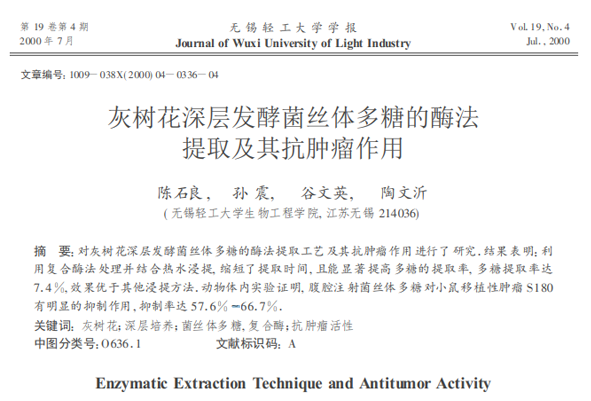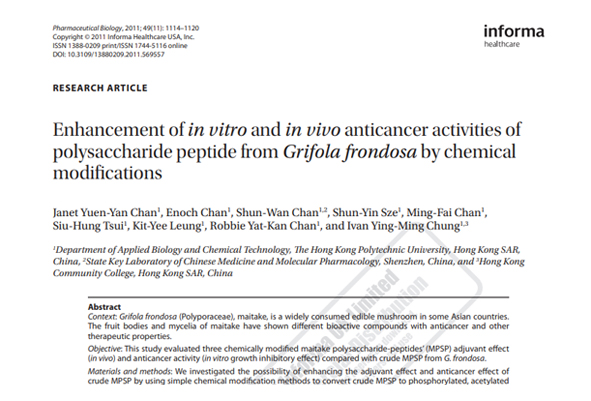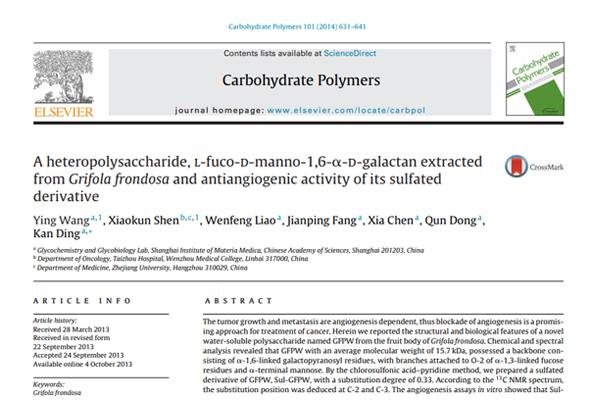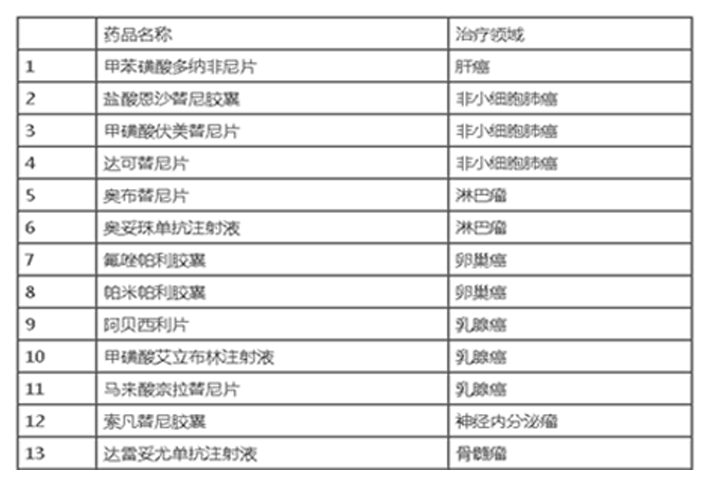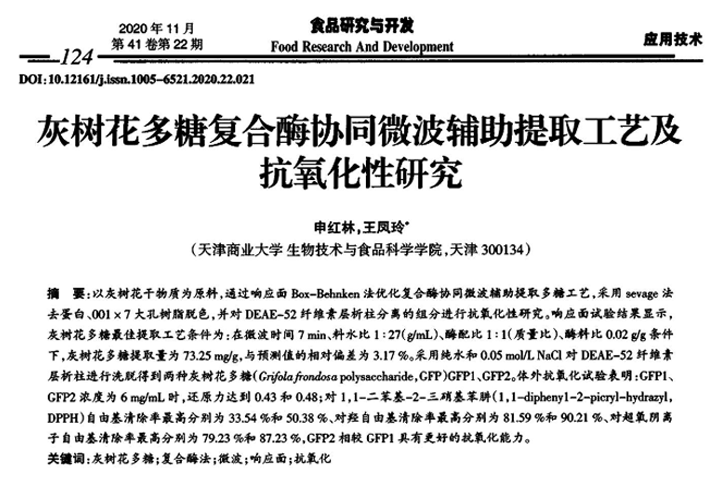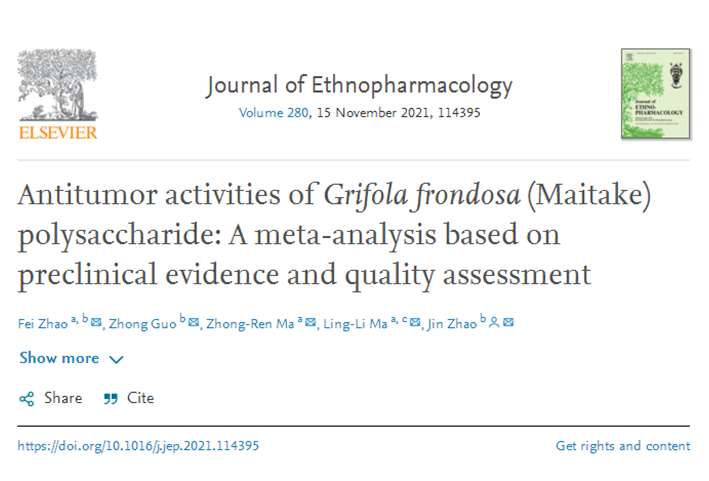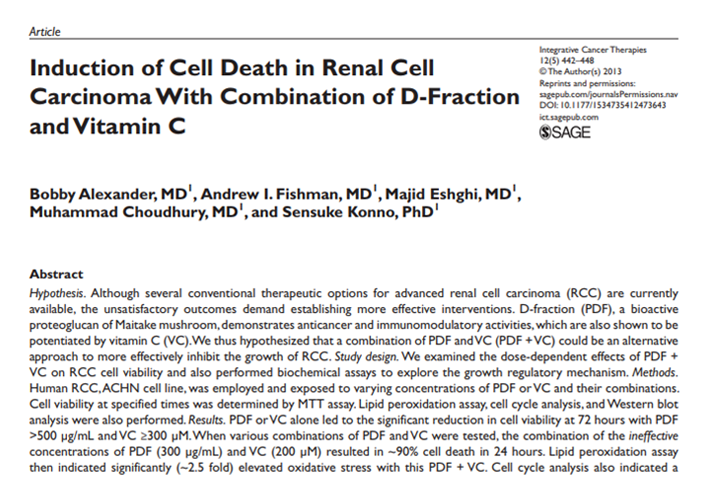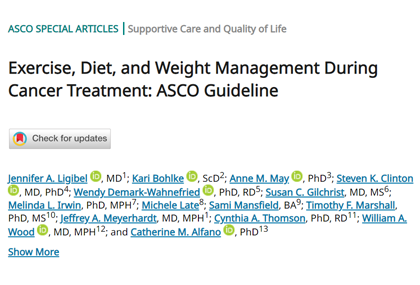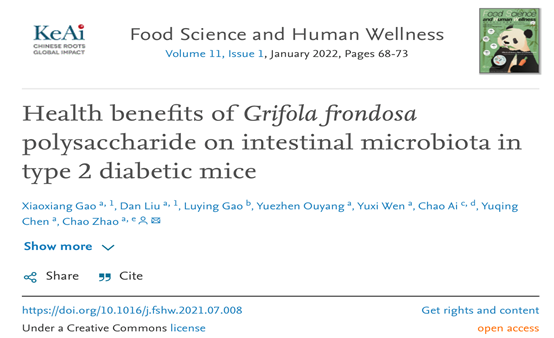
Introduction
Grifola frondosa, also known as dancing velvet, is a porous fungus of basidiomycetes, belonging to barnyard grass family, rich in carbohydrate, vitamin, protein and other nutrients. It is also considered as a valuable food ingredient and nutritional supplement because of its biological activities such as anti-tumor, anti-virus, anti-oxidation, anti-inflammatory, hypoglycemic, hypolipidemic and immune regulation.
The new polysaccharide extracted from Grifola frondosa can be inhibited by α- Glucosidase, regulating insulin resistance and promoting glycogen synthesis can effectively reduce blood glucose concentration, but there are few studies on the regulatory effect of Grifola frondosa polysaccharide (GFP) on high-fat diet induced mice. There are about 1 trillion kinds of organisms in the human gut, which is regarded as the second brain. Bacteria constitute the majority of all microbial cells in the human intestinal flora. The metabolism of bacteria in the gastrointestinal tract is closely related to human health. The metabolic map of human intestinal microorganisms reflects the synergy between different system types, with more than 1000 species, of which about 90% belong to Firmicutes and Bacteroidetes, followed by actinobacteria and Proteus. The ecological balance is the result of the interaction between the intestinal flora and the host, but the intestinal flora disorder caused by various factors can lead to the emergence of chronic diseases, such as type II diabetes, obesity and inflammatory bowel disease. More studies have shown that intestinal microorganisms can promote the utilization of sugars and the release of triglycerides by the liver, thereby regulating insulin resistance. However, it was found that the number of beneficial bacteria decreased, the number of pathogenic bacteria increased, and the intestinal barrier function was impaired in patients with diabetes. Therefore, it is necessary to explore an effective material to reduce the intestinal injury in patients with diabetes.
Xiaoxiang Gao, Dan Liu and Chao Zhao * of Fujian agriculture and Forestry University used mouse models to explore the regulatory effect of GFP on intestinal microbiota imbalance. In view of the possible interaction between intestinal flora and disease, the changes of intestinal flora in diabetes mice treated with GFP were studied by second-generation sequencing and multiple statistical analysis; The regulation of GFP was expounded from the changes of gut microbiota at different levels (phylum and genus levels); In addition, a direct comparison of the relative abundance of beneficial bacteria strains between diabetes mice and GFP treated mice was also provided to verify its potential protective function against diabetes.
Results and Discussion
Sequencing and data processing of intestinal flora
After removing unreasonable sequences, the total number of effective sequences in the original data was 70785 BP, and the tag length distribution of mouse gut microbial sequences was mainly around 1500 BP (Fig. 1a). Clusters with 97% sequence similarity were used for OTU clustering and partitioning. A total of 941 OTUs in all four groups were identified. There were 80 OTUs in each group, and 39 OTUs in the normal group, gfph and gfpl groups. However, the model group shares only 10 OTUs with the gfph and gfpl groups, which indicates that the microbiota of normal mice and diabetes mice are different. In addition, Venn diagram showed that 181, 99128 and 203 OTUs were unique to the normal group, model group, ufph and ufpl groups, respectively (Fig. 1b).
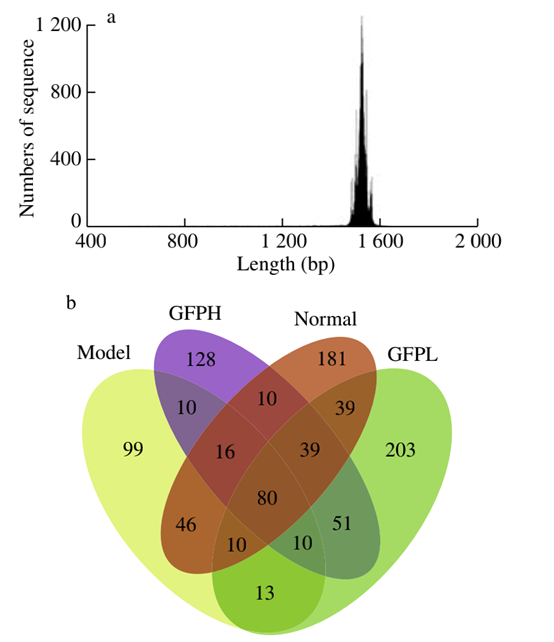
Fig. 1 effective sequence length distribution of mouse gut microbial sequence tags (a); Venn diagram of OTU distribution in normal group, model group, gfpl and gfph group (b)
α- Diversity analysis
Changes in gut diversity and structure in all treated mice were identified by genomic analysis. The sparse curve of each sample increased sharply and then flattened, indicating that the sequencing depth was sufficient to reflect the diversity of the intestinal community (Fig. 2a). Grade abundance curves were used to estimate the abundance and evenness of intestinal microorganisms. Compared with other samples, gfpl1 has the longest curve length, which indicates that most OTUs are determined in gfpl1. In addition, the curve gradient in gfph2 and gfpl1 flattened with the sequence, indicating that the microorganisms were highly uniform in the 2 samples. In addition, the abundance and evenness of the microbiota in the same group of samples showed slight differences (Fig. 2b). Shannon diversity index and Simpson index showed that there was no significant difference between the four groups (P > 0.05) (Fig. 2c, d), which indicated that GFP could not disrupt the diversity of the gut microbiota.
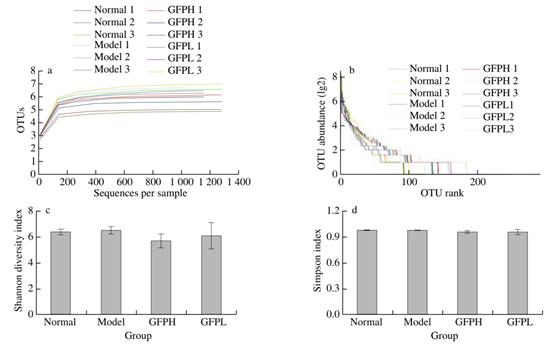
Fig. 2 dilution curve (a) and rank abundance curve (b) of each sample in each group, Shannon diversity (c) and Simpson index (d) of different populations
Analysis of intestinal flora variation
This analysis aims to reveal the regulatory effect of GFP on microbial community structure in diabetes mice. According to the relative abundance, a total of 7 phyla were detected, of which Firmicutes, Bacteroidetes and Proteobacteria were the top 3 in the 4 groups. After administration, compared with the normal group and the model group, the number of Bacteroides significantly increased. In addition, the relative abundance of Bacillus verrucus in diabetes mice was significantly decreased after treatment with high concentrations of GFP (Fig. 3a). According to previous studies, a decrease in the proportion of Firmicutes was found in mice fed a high-fat diet, and GFP can effectively regulate the intestinal structure at the phylum level. In addition, the proportion of Bacteroidetes is the highest, which is different from the results determined by the third-generation sequencing technology based on single molecule real-time sequencing. The genus level heat map shows that some high abundance species are obviously affected by GFP, including desulfurizing Vibrio, Helicobacter pylori, alistipes, Lactobacillus and Bacteroides. The relative abundance of barnesiella and alistipes in diabetes mice was significantly lower than that in the normal group and GFP group, and the level of barnesiella was significantly increased after gfph treatment (Fig. 3b). Barnesiella belongs to Bacteroides, and its content is the highest in the gfph group mice. It is considered as a beneficial bacteria that protects the host intestinal tract by eliminating pathogenic bacteria. It has been demonstrated that increased alistipes levels can prevent dextran sulfate induced colitis in mice. Interestingly, a relatively high abundance of alistipes was found in the gfpl group, while the highest content was found in the gfph group determined by the third-generation sequencing, which indicates that there is a difference in degradability between the second and third-generation sequencing. In addition, several microbiomes with relatively low abundance were significantly changed under GFP treatment. After GFP administration, the relative abundances of isopravia and rosacea were significantly increased (P < 0.05). In contrast, green fluorescent protein treatment could reduce the abundance of Ruminococcus and Prevotella in diabetes mice (Fig. 3C). Alloprovetella is a dominant beneficial bacterium commonly found in human and mouse intestines. In addition, the abundance of rose sacs in patients with Crohn's disease showed a downward trend. Flagellin released by Roseburia can improve the expression of hif1a-as2 by phosphorylating STAT1, thus preventing colitis. More importantly, the microbiota with relatively low abundance changed significantly, which may be beneficial to the remission of hyperglycemia. The relative abundance of beneficial and harmful microorganisms indicates that GFP plays a protective role in the gut of diabetes mice.

Compared with the normal group, * P < 0.05, * * P < 0.01; Compared with the model group, P < 0.05, P < 0.01.
Fig. 3 metagenomic analysis of gut microbiota at different animal phyla levels (a), genus level gut microbiota heat map (b), relative abundance (c)
Classification of intestinal taxa
Lefse measurements were performed to investigate different microbiota in the normal group, the model group, the gfph group, and the gfpl group (Fig. 4). Among these taxa, 28 genera were detected with significant differences. Compared with the normal group, the number of Robinson bacteria, flavonoid pathogenic bacteria, anaerobic bacteria and desulfurizing Vibrio in the model group was abundant. Compared with GFP treated mice, the LDA scores of E. coli, pasteurella and H. pylori were higher in diabetes mice. In addition, the LDA scores of Lactobacillus and Geobacillus in the GFP group were significantly higher than those in the model group. Robinsonella and Helicobacter pylori can respectively produce odorous chemicals and trigger proinflammatory reactions, thus causing damage to human health. In addition, GFP can increase the number of Burkholderia in diabetes mice. Lactic acid and hydrogen peroxide released by lactic acid bacteria play an important role in maintaining intestinal microenvironment balance. Under GFP treatment, it was found that the number of lactic acid bacteria in diabetes mice was improved.
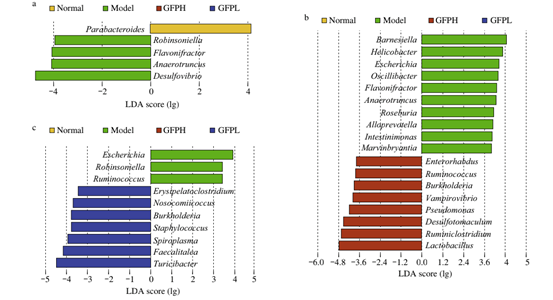
(a) Normal group and model group; (b) Compared with the model group; (c) Gfpf and model group.
Fig. 4 lefse analysis of intestinal taxa at genus level in normal group, model group, gfph group and gfpl group
Potential relationships between microbiomes
16S rRNA high-throughput sequencing opens the way for predicting the potential relationship of the microbiome. In addition, studies on the relationship between samples have recently been utilized to describe complex interaction networks, changes in the microbiota may be attributed to interactions between the microbiota, and correlations between the microbiomes were visualized by corrplot analysis and Cytoscape software. Obviously, there is a strong coexistence between Burkholderia and Pseudomonas, as well as desulfurizing bacteria and Clostridium ruminant. Pseudomonas, desulfurizing bacteria, Burkholderia, and Pseudomonas were negatively correlated with isoprospinia, especially Pseudomonas with an R value of -0.9136 (Fig. 5a). In addition, alloprovetella and Burkholderia had a strong correlation with the five bacterial groups (Fig. 5b). The abundances of Pseudomonas, Bemisia and Helicobacter pylori are closely related to the microbiota, and further studies are needed to verify the interaction mechanism between the strongly related microbiota.
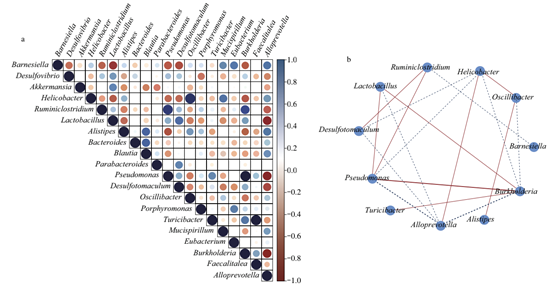
Red lines with solid lines indicate positive correlation; Dotted blue lines indicate negative correlation; The width of the line represents the intensity of the R value.
Figure 5 Correlation (a) and network (b) of dominant bacteria
Conclusion
The regulation of GFP on the imbalance of fecal microbiota in diabetes mice was studied. Studies have shown that GFP can improve the composition of gut microbiota and promote the proliferation of beneficial bacteria. After GFP treatment, the relative abundance of intestinal flora at phylum and genus levels changed. The results indicate that GFP may be an effective substance to improve the intestinal health of patients with diabetes.
Health benefits of Grifola frondosa polysaccharide on intestinal microbiota in type 2 diabetic mice
Xiaoxiang Gaoa,1, Dan Liua,1, Luying Gaob, Yuezhen Ouyanga, Yuxi Wena, Chao Aic,d, Yuqing Chena, Chao Zhaoa,e,*
a College of Food Science, Fujian Agriculture and Forestry University, Fuzhou 350002, China
b Department of Pediatrics, Nanjing First Hospital, Nanjing Medical University, Nanjing 210006, China
c School of Food Science and Engineering, South China University of Technology, Guangzhou 510641, China
d Department of Food Science & Technology, National University of Singapore, Singapore 117543, Singapore
e Engineering Research Centre of Fujian-Taiwan Special Marine Food Processing and Nutrition, Ministry of Education, Fuzhou 350002, China
*Corresponding author.
E-mail address: zhchao@live.cn
Abstract
Grifola frondosa polysaccharide (GFP) as the natural compounds have been reported to exert diverse bioactivities. The aim of this study was to investigate the regulatory effects of GFP on intestinal microbiota in type 2 diabetic mice. The changes of microbiota in faeces of the diabetic mice upon high fat diet were determined and the V3 region of the 16S rRNA was sequenced by Illumina MiSeq high-throughput sequencing platform. Eighty operational taxonomic unit were identified to be shared by all samples, and the quality and richness of sequencing were assessed via rarefaction and rank abundance curves. The diversity of gut flora was slightly improved in diabetic mice after GFP treatment. The composition and relative abundance of gut microbiota at phylum and genus levels were altered by GFP. The abundance of Robinsoniella, Flavonifractor, Anaerotruncus, and Desulfvibrio were found to concentrate on diabetic mice through LEfSe analysis. Furthermore, Alloprevotella and Burkholderia had strong relevancy with other gut flora. Based on the findings, GFP might be a desired candidate on ameliorating the intestinal unbalance in diabetes.
Reference:
GAO X X, Liu D, GAO L Y, et al. Health benefits of Grifola frondosa polysaccharide on intestinal microbiota in type 2 diabetic mice[J]. Food Science and Human Wellness, 2022, 11(1): 68-73. DOI:10.1016/j.fshw.2021.07.008.
Source link:



